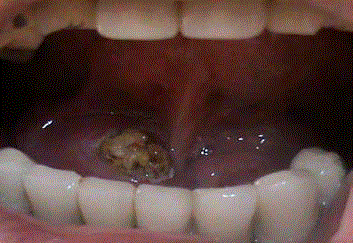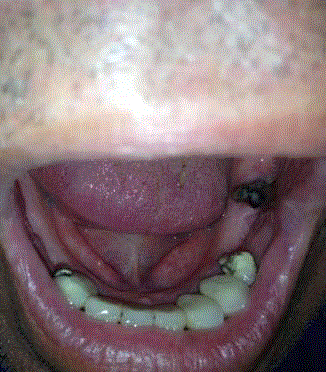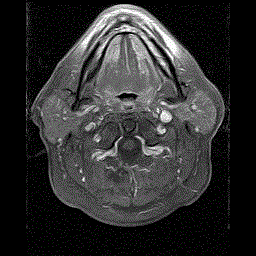Case Report
Unilateral Submandibular Gland Agenesis Associated with Sublingual Sialolithiasis Perforating the Floor of the Mouth
Işil Adadan Güvenç1*, Erkan Eşki1 and Hasan Yerli2
1Department of Otolaryngology Head and Neck Surgery, Başkent University Zübeyde Hanim Practice and
Research Center, İzmir, Turkey
2Department of Radiology, Başkent University Zübeyde Hanim Practice and Research Center, İzmir, Turkey
*Corresponding author: Işil Adadan Güvenç, Department of Otolaryngology-Head and Neck Surgery, Başkent University, Zübeyde Hanim Practice and Research Center, 8110/1 Sk. No:4 Çiğli, İzmir, Turkey
Published: 27 Sep, 2017
Cite this article as: Güvenç IA, xEşki IA, Yerli H. Unilateral
Submandibular Gland Agenesis
Associated with Sublingual Sialolithiasis
Perforating the Floor of the Mouth. Clin
Surg. 2017; 2: 1638.
Abstract
Introduction: Isolated unilateral submandibular gland agenesis is an uncommon disorder.
Submandibular gland agenesis with sublingual sialolithiasis has never been reported.
Case Report: We report a case of unilateral submandibular agenesis perforating the floor of the
mouth that may be associated with ipsilateral sublingual sialolithiasis.
Conclusion: Due to the complicated anatomy of the ducts of submandibular and sublingual
glands, the origin of a sialolith in the floor of the mouth may not be clearly identified in a case it
has perforated the floor of the mouth. Although the origin of the sialolith was considered to be the
sublingual gland, submandibular glandular atrophy secondary to recurrent sialolithiasis should also
be considered. Radiologic studies and probing may assist in differential diagnosis.
Keywords: Submandibular gland; Sublingual gland; Aplasia; Agenesis; Sialolithiasis; Floor of
the mouth
Introduction
Developmental agenesis of submandibular gland is an uncommon anomaly. This agenesis may occur secondary to defects of first and second branchial arches. Submandibular Gland Agenesis (SMA) appears alone or with other facial anomalies such as lacrimal gland hypoplasia, canalicular atresia, absence of lacrimal punctum, mandibulofacial dysostosis (Treacher-Collins syndrome), or congenital malformations of the temporomandibular component [1]. The 85% - 90% of sialolithiasis cases develops in the submandibular gland; 5% - 20% of cases are found in the parotid gland and 1% - 2% presents in the sublingual and minor salivary glands [2]. The saliva of the sublingual gland is more a pure mucus type and the viscosity of the secretion of the salivary gland are six-fold that of the submandibular gland. In addition, the saliva outflow of the sublingual gland is slower than that of the submandibular gland, and also has an anti-gravity flow pattern [3]. Unilateral SMA is usually associated with contralateral submandibular and/or ipsilateral sublingual gland hypertrophy. Ipsilateral sublingual gland may show hypertrophy in order to increase the production of saliva. Hypertrofied sublingual gland may mimic a cervical mass [2,4]. There are only five reported cases of ipsilateral sublingual gland hypertrophy with SMA in the English literature [4-6]. Isolated unilateral SMA with ipsilateral sublingual sialolithiasis has not been reported previously. We report an incidentally detected case of a sublingual sialolithiasis with ipsilateral submandibular aplasia.
Case Presentation
A 67-year-old man was admitted to our clinic with otalgia on the left side. He had no history of head and neck surgery or of swelling in the submandibular region. He had no dry mouth or Dysphagia. During otolaryngologic examination, a sialolith perforating the floor of the mouth was seen incidentally in the right sublingual area (Figure 1A). Because of the anteromedial location of the sialolith, the orifice of the submandibular duct could not be identified. Saliva expelled from the normal left orifice on pressure of the right submandibular area while no saliva flow was seen on the right. Some of the teeth of the patient were lacking and oral hygiene was moderate. The right submandibular gland was not felt with bimanuel palpation. General physical examination showed no other associated anomaly. The laboratory results were within normal limits. The ultrasound examination demonstrated a 1.5 cm × 1 cm sialolith in the right sublingual area with the absence of the right submandibular gland. A computed tomography (CT) scan confirmed the finding of right SMA with sialolithiasis in the sublingual area (Figure 1B). The right submandibular gland was replaced by fat and the left was normal. A surgical exploration was performed under local anesthesia with sedation. Sialolithectomy was performed by transoral approach. One year later, in intraoral examination no sialolith was seen, but the right sublingual bulge was less significant than the left one (Figure 1C). Probing of the orifice of Wharton’s duct revealed the duct to be patent but there was no flow of saliva upon pressure. Magnetic resonance imaging (MRI) demonstrated right SMA, there was no difference in size or structure between the right and left sublingual gland (Figure 1D).
Figure 1A
Figure 1B
Figure 1B
CT image shows agenesis of right submandibular gland and
normal left submandibular gland and sialolithiasis of the right sublingual
region (arrow)..
Figure 1C
Figure 1C
Postoperative first year. No sialolith was seen in intraoral
examination, but the right sublingual bulge was less significant than the left
one.
Figure 1D
Figure 1D:
Postoperative MRI shows normal sublingual glands. There was
no difference in size and structure between the right and left sublingual gland.
Discussion
Since Bruno described the first case of unilateral SMA in 1894, twenty-one cases have been reported in the literature. The clinical picture is variable. Patients can be asymptomatic or may complain of dry mouth, dysphagia, difficulty in chewing or swallowing and multiple dental caries [1,6]. Our patient did not have any symptoms related to this entity. According to Johns, the salivary glands arise by the proliferation and in growth of the oral epithelium as a solid cord of cells into the underlying mesenchymal tissues at about the fourth to eighth week of fetal development. As development progresses, these cords undergo extensive branching, enlarge in size, and acquire lumens. The parotid gland is the first of the major salivary glands followed by submandibular glands. Lastly the sublingual glands arise in the eighth week as an independent row of small glands with individual ducts [7]. Congenital unilateral absence of the submandibular gland is an isolated phenomenon and may result from other unique defects of early fetal development, unlike the cause of multiglandular agenesis associated with other facial anomalies. Depending on the stage the fetal development is interrupted, aplasia of Wharton’s duct may accompany isolated aplasia of a unilateral submandibular gland or the duct may remain as a stump (Wharton’s stump.) In fact, there are four cases of isolated aplasia of a unilateral submandibular gland reported in the literature associated with the formation of a sialolith within the remaining Wharton’s duct [8,9]. The cause of sialolithiasis within the ipsilateral remaining Wharton’s duct without unilateral submandibular gland is uncertain. Retrograde contamination of the remaining Wharton’s duct with desquamated epithelial cells, microorganisms or lysosomes derived from the salivary duct may lead to formation of a sialolith. Patton reported three patients who developed submandibular duct calculi years after the submandibular gland had been removed. The basis for this was presumed to be the existence of communications between the sublingual glandular complex and the remaining submandibular duct). The reverse can also be true. It is reported that, complete acinar atrophy secondary to an early obstruction of Wharton´s duct may result in absence and fat replacement of the submandibular gland, resulting in formation of a sialolith within the remaining Wharton’s duct [9]. The duct of sublingual gland and submandibular duct intermingle with each other. The major part of the sublingual gland drains by a main duct (Bartholin’s duct) either directly into the floor of the mouth or into the submandibular duct just before it opens at the sublingual caruncula of the remaining two posterior divisions of the gland, one is often fused to the major sublingual gland and empties by numerous small ducts into the submandibular duct. Some of these may join to form a distinct posterior sublingual duct. The remaining division of the gland lies superiorly and opens by 5-15 small ducts (ducts of Rivini) directly into the floor of the mouth. Due to this complicated anatomy of the ducts of submandibular and sublingual glands, the origin of a sialolith in the floor of the mouth is almost impossible to find. Probing of the orifice of Wharton’s duct during surgery may be useful in identification, but this was not possible in our case since the sialolith had perforated the floor of the mouth from an anatomic point of view, the duct of the sublingual gland is shorter and has multiple openings that may drain mucoid saliva more efficiently. Even if a stone develops, it may not cause total obstruction of saliva outflow and subsequent infection. Therefore, most sublingual gland sialoliths are asymptomatic and remain underdiagnosed. This may be the case in our patient since the sialolith was asypmtomatic even if it was a fairly large-sized calculus which had perforated the floor of the mouth. However it is rare for a large stone located in Wharton’s duct not to produce any symptoms of inflammation or pain [10]. When the stone is located within the sublingual gland, it is not difficult to identify which portion of the gland is involved using CT. However, most stones (75% - 85%) are located in a sublingual duct. When a stone is located in a duct, without a change in the gland, a stone in the sublingual gland duct may be easily misdiagnosed as being proximally located in Wharton’s duct, even using CT. In these cases, conventional sialography or MR sialography may help the differential diagnosis. However these methods would not be useful in our case since the duct could not be identified. The ability of CT to successfully differentiate the sublingual gland from the neighbouring muscles is limited. However, MRI is superior compared to CT in the differential diagnosis of the lesions in this space. Unfortunately, it was not obtained preoperatively. Scintigraphy is a good method for determining the functional activity of the salivary glands, not their anatomy, so it would not be useful in our case [10]. The management of sublingual sialolithiasis depends on the size and location of sialolith. Usually sublingual sialolithectomy or sialoadenectomy transorally is the preferred treatment. Lithotripsy and interventional sialendoscopy have also been used. Considering the asymptomatic occurrence of the sialolith, we preferred transoral sublingual sialolithectomy.
Conclusion
Unilateral SMA presenting with sublingual sialolithiasis is a rare and confusing anomaly. In case of the absence of the submandibular gland, a sialolith localized in the sublingual area may arise from the sublingual gland or Wharton’s stump, or such a case may be the result of submandibular glandular atrophy secondary to recurrent sialolithiasis as well. Previous symptoms reported by the patient, radiologic studies and probing of the duct may assist in identification of the origin of sialolith.
References
- Yilmaz M, Karaman E, Isildak H, Enver O, Kiliç F. Symptomatic unilateral submandibular gland aplasia associated with ipsilateral sublingual gland hypertrophy. Dysphagia. 2010;25:70-2.
- Patton DW. Recurrent calculus formation following removal of the submandibular salivary gland. Br J Oral Maxillofac Surg. 1987;25(1):15-20.
- Liao LJ, Hsiao JK, Hsu WC, Wang CP. Sublingual gland sialolithiasis: a case report. Kaohsiung J Med Sci. 2007;23(11):590-3.
- Yerli H. Dynamic sonography and CT findings of unilateral submandibular gland agenesis associated with herniated hypertrophic sublingual gland. J Clin Ultrasound. 2014;42(3):176-9.
- Herrera-Calvo G, García-Montesinos-Perea B, Saiz-Bustillo R, Gallo-Terán J, Lastra-García-Barón P. Unilateral submandibular gland aplasia with ipsilateral sublingual gland hypertrophy presenting as a neck mass. Med Oral Patol Oral Cir Bucal. 2011;16(4):e537-40.
- Kara M, Güçlü O, Dereköy FS, Resorlu M, Adam G. Agenesis of Submandibular Glands: A Report of Two Cases with Review of Literature. Case Reports in Otolaryngology. 2014;5.
- Johns ME. The salivary glands: anatomy and embryology. Otolaryngol Clin North Am. 1977;10(2):261-71.
- Koo BS, Lee SW, Lee YM, Lee JD, Koh YW. Sialolithiasis in a stump of Wharton's duct of an aplastic unilateral submandibular gland. Int J Oral Maxillofac Surg. 2009;38(1):93-5.
- García-Consuegra L, Rosado P, Gallego L, Junquera L. Unilateral absence of submandibular gland secondary to stones. Aplasia versus early atrophy. Med Oral Patol Oral Cir Bucal. 2010;15(5):e752-4.
- Rzymska-Grala I, Stopa Z, Grala B, Golebiowski M, Wanyura H, Zuchowska A, et al. Salivary gland calculi - contemporary methods of imaging. Pol J Radiol. 2010;75(3):25-37.



